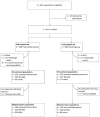Influence of pharmacist intervention on drug safety of geriatric inpatients: a prospective, controlled trial
- PMID: 31019678
- PMCID: PMC6469284
- DOI: 10.1177/2042098619843365
Influence of pharmacist intervention on drug safety of geriatric inpatients: a prospective, controlled trial
Abstract
Background: Demographic shift leads to an increasing number of geriatric patients suffering from multimorbidity and resulting polypharmacy. Polypharmacy is shown to be associated with drug-related problems (DRPs) and increased morbidity. For Germany, a hospital-based intervention may be successful optimizing of polypharmacy. The aim of this study was to reduce DRPs in geriatric inpatients by a structured pharmacist's intervention and to measure the acceptance rate of pharmaceutical recommendations.
Methods: This study followed an open, prospective, quasi-randomized, controlled design and was conducted in a geriatric department in a teaching hospital in Germany. Patients of all sexes were included, with a minimum age of 70 years, a written informed consent and a regular intake of at least five drugs daily. Primary outcome was the percentage of patients having a DRP at admission and discharge. A DRP was defined as a prescription without indication or a relevant drug-drug interaction or prescription of a potentially inappropriate medication or presence of an adverse drug reaction. Recommendations were classified and discussed face to face. Statistical analyses were performed using a full-set analysis and a matched-pairs design.
Results: Within 12 months, 411 patients were recruited with median age of 82 years (intervention: n = 209; control: n = 202). Median number of drugs at admission was 10 (range 5-24), at discharge 9 (range 3-21). In the intervention group, the percentage of patients with a DRP was reduced from 86.6% to 56.0%; in the control group, from 76.7% to 76.2% (p value < 0.001). Medication appropriateness index score was reduced by 56% in the intervention group and by 0.2% in the control group (p value < 0.001). Implementation rate of the pharmaceutical recommendation was 80%.
Conclusion: This prospective controlled trial showed that a pharmacist's intervention was successful in optimizing polypharmacy in geriatric inpatients.
Keywords: drug safety; geriatric inpatients; medication appropriateness index; pharmaceutical intervention; polypharmacy; potentially inappropriate medication.
Conflict of interest statement
Conflict of interest statement: The author(s) declared no potential conflicts of interest with respect to the research, authorship, and/or publication of this article.
Figures



Similar articles
-
Medication review versus usual care to improve drug therapies in older inpatients not admitted to geriatric wards: a quasi-experimental study (RASP-IGCT).BMC Geriatr. 2018 Jul 3;18(1):155. doi: 10.1186/s12877-018-0843-y. BMC Geriatr. 2018. PMID: 29970005 Free PMC article.
-
Combined Use of the Rationalization of Home Medication by an Adjusted STOPP in Older Patients (RASP) List and a Pharmacist-Led Medication Review in Very Old Inpatients: Impact on Quality of Prescribing and Clinical Outcome.Drugs Aging. 2017 Feb;34(2):123-133. doi: 10.1007/s40266-016-0424-8. Drugs Aging. 2017. PMID: 27915457
-
Drug Therapy Safety in Palliative Care-Pharmaceutical Analysis of Medication Processes in Palliative Care.Pharmacy (Basel). 2023 Oct 7;11(5):160. doi: 10.3390/pharmacy11050160. Pharmacy (Basel). 2023. PMID: 37888505 Free PMC article.
-
Risk Factors Associated with the Requirement for Pharmaceutical Intervention in the Hospital Setting: A Systematic Review of the Literature.Drugs Real World Outcomes. 2016 Sep;3(3):241-263. doi: 10.1007/s40801-016-0083-4. Drugs Real World Outcomes. 2016. PMID: 27747829 Free PMC article. Review.
-
Prevalence and Risk of Polypharmacy Among Elderly Cancer Patients Receiving Chemotherapy in Ambulatory Oncology Setting.Curr Oncol Rep. 2018 Mar 26;20(5):38. doi: 10.1007/s11912-018-0686-x. Curr Oncol Rep. 2018. PMID: 29582192 Review.
Cited by
-
Decision support software-guided medication reviews in elderly patients with polypharmacy: a prospective analysis of routine data from community pharmacies (OPtiMed study protocol).J Pharm Policy Pract. 2022 Dec 9;15(1):100. doi: 10.1186/s40545-022-00495-z. J Pharm Policy Pract. 2022. PMID: 36494764 Free PMC article.
-
Evaluation of a score for identifying hospital stays that trigger a pharmacist intervention: integration into a clinical decision support system.JAMIA Open. 2025 May 5;8(3):ooaf030. doi: 10.1093/jamiaopen/ooaf030. eCollection 2025 Jun. JAMIA Open. 2025. PMID: 40330112 Free PMC article.
-
Medication review in hospitalised patients to reduce morbidity and mortality.Cochrane Database Syst Rev. 2023 Jan 23;1(1):CD008986. doi: 10.1002/14651858.CD008986.pub4. Cochrane Database Syst Rev. 2023. PMID: 36688482 Free PMC article.
-
An Improved Comprehensive Medication Review Process to Assess Healthcare Outcomes in a Rural Independent Community Pharmacy.Pharmacy (Basel). 2019 Jun 17;7(2):66. doi: 10.3390/pharmacy7020066. Pharmacy (Basel). 2019. PMID: 31212922 Free PMC article.
-
STOPP-START Medication Review: A Non-Randomized Trial in an Indonesian Tertiary Hospital to Improve Medication Appropriateness and to Reduce the Length of Stay of Older Adults.Hosp Pharm. 2021 Dec;56(6):668-677. doi: 10.1177/0018578720942227. Epub 2020 Jul 13. Hosp Pharm. 2021. PMID: 34732920 Free PMC article.
References
-
- Lehnert T, Heider D, Leicht H, et al. Review: Health care utilization and costs of elderly persons with multiple chronic conditions. Med Care Res Rev 2011; 68: 387–420. - PubMed
-
- Van den Akker M, Buntinx F, Knottnerus JA. Comorbidity or multimorbidity. Eur J Gen Pract 2009; 2: 65–70.
-
- Reeve E, Wiese MD, Mangoni AA. Alterations in drug disposition in older adults. Expert Opin Drug Metab Toxicol 2015; 11: 491–508. - PubMed
-
- Gnjidic D, Johnell K. Clinical implications from drug-drug and drug-disease interactions in older people. Clin Exp Pharmacol Physiol 2013; 40: 320–325. - PubMed
-
- Gnjidic D, Hilmer SN, Blyth FM, et al. Polypharmacy cutoff and outcomes: five or more medicines were used to identify community-dwelling older men at risk of different adverse outcomes. J Clin Epidemiol 2012; 65: 989–995. - PubMed
LinkOut - more resources
Full Text Sources

